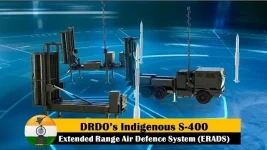- Views: 1K
- Replies: 8
In a recent interview with Bharat Shakti, Manoj Jain, Chairman and Managing Director (CMD) of Bharat Electronics Limited (BEL), revealed crucial information about the MF-STAR radar system deployed on many of India's frontline warships.
His revelations confirm the impressive range of this radar and suggest its potential integration with advanced missile systems like Project Kusha's M1 and M2, significantly extending the Indian Navy's air defence capabilities.
According to Jain, the MF-STAR (Multi-Function Surveillance, Track and Guidance Radar) boasts an impressive range of 400 nautical miles (approximately 750 kilometers). This extended reach allows for the detection of aerial threats, including fighter jets and Maritime Patrol Aircraft (MPA), at significantly greater distances. This early warning capability provides the Indian Navy with a strategic advantage in threat assessment and response.
With a 400 NM detection range, the Indian Navy can monitor a vast airspace, providing ample time to react to incoming threats. This is crucial in modern naval warfare, where the ability to detect and respond quickly is paramount.
The potential integration of the MF-STAR radar with Project Kusha's M1 and M2 missiles is poised to significantly enhance the defensive capabilities of Indian warships. This DRDO initiative focuses on developing advanced missile systems, with the M1 and M2 specifically designed for extended-range air defence. Combining the missiles' capabilities with the MF-STAR's long-range detection could enable Indian warships to engage aerial targets at distances exceeding 250 kilometers.
This development would be a game-changer for the Indian Navy, allowing it to neutralize threats well beyond visual range and effectively expanding the defensive perimeter around its naval assets. The synergy between the MF-STAR radar and the forthcoming missile systems under Project Kusha represents a significant leap forward in India's naval defence capabilities.
The ability to detect and engage targets at such extended ranges not only acts as a deterrent but also bolsters the defence of naval operations, particularly in contested maritime zones. This integration provides greater operational flexibility, allowing Indian naval ships to operate more confidently in hostile environments with the knowledge that they can counter threats at a significant standoff distance.
Jain's comments highlight India's ongoing efforts to strengthen its naval capabilities through indigenous technology. The integration of these advanced systems is expected to transform naval engagements, emphasizing the growing importance of technological superiority in modern warfare.


